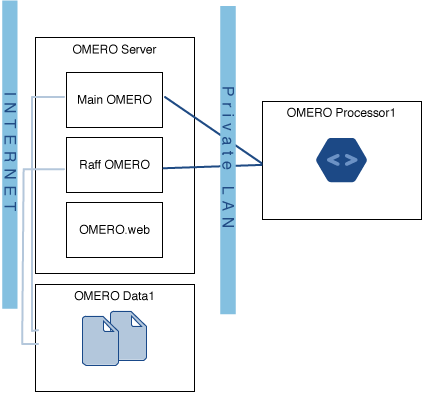Note
This documentation is for the new OMERO 5.1. version. See the latest OMERO 5.0.x version or the previous versions page to find documentation for the OMERO version you are using if you have not upgraded yet.
Example production server set-ups¶
Micron, Oxford¶
The OMERO server at Micron, Oxford houses two OMERO instances, the databases for both these instances, and a single OMERO.web instance which serves them both. The second OMERO instance (Raff OMERO) originated from another group’s private OMERO server, which is now managed by Micron, but there was no way to merge this data into the main server. The main OMERO instance is configured to interface to a departmental LDAP server to authenticate users and get initial authorization details.

OMERO Data1 in the diagram is a large filestore server which hosts all the image data. This is made available to the OMERO server itself via a Samba mount. This server has 36 TiB of space of which OMERO is using 16 TiB and Raff OMERO is using 600 GiB. This is backed up to a tape robot.
OMERO Processor1 consists of a 32 core, 128GiB RAM processing machine for doing image analysis. This is connected on a completely private network to the OMERO server (to avoid issues with configuring OMERO.grid to be secure) and runs scripts using OMERO.grid.
Stats¶
- 90 users
- 40 groups
- 36 TiB of data storage space, of which 16.6 TiB is currently in use
- Performance statistics to come
Biozentrum, University of Basel¶
The OMERO server at Biozentrum has around 82 users and currently uses 9.8 TB of data storage space, with an average monthly increase of 200-300 GB. It is run on CentOS 6.5 with data hosted on an NFS-mounted NAS system.
Hardware¶
Remote storage consists of:
- NFS-mounted NAS system
Local storage consists of:
- 2 x 146 GB 6Gbit/s SAS HD, RAID 1. OS and OMERO software
- 2 x 128 GB SSD, RAID 1, Postgres DB
- 2 x 600 GB 6Gbit/s SAS HD, scratch space, buffer, etc.
Computational resources:
- IBM x3550 M4, dual-CPU Intel(R) Xeon(R) E5-2643 3.3GHz, physical
- 32 GB of memory
Network infrastructure¶
- 1 Gbit/s Ethernet, local, VPN support, dedicated
GReD Research Center, Clermont-Ferrand, France¶
The Genetics, Reproduction and Development Research Center has 65 users and currently uses 3 TB of storage, with an average monthly increase of 90 GB. It is run on Debian Squeeze.
Hardware¶
- 11 TB of storage spread over 8 local hard drives (2 TB), RAID 5
Computational resources:
- 1 Intel Xeon E5506 (4 physical cores)
- 8 GB of memory
Network infrastructure¶
The server is hosted inside the faculty of medicine where the network works at 100 Mbit/s. There are are 4 Gbit/s ports on the server but only one is currently in use.